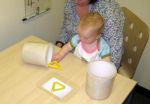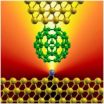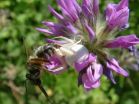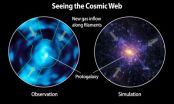(Press-News.org) Babies begin to learn about the connection between pictures and real objects by the time they are nine-months-old, according to a new study by scientists at Royal Holloway, University of London, and the University of South Carolina.
The research, published today in Child Development, found that babies can learn about a toy from a photograph of it well before their first birthday.
"The study should interest any parent or caregiver who has ever read a picture book with an infant," said Dr Jeanne Shinskey, from the Department of Psychology at Royal Holloway. "For parents and educators, these findings suggest that, well before their first birthdays and their first words, babies are capable of learning about the real world indirectly from picture books, at least those that have very realistic images like photographs."
Researchers familiarized 30 eight and nine-month-olds with a life-sized photo of a toy for about a minute. The babies were then placed before the toy in the picture and a different toy and researchers watched to see which one the babies reached for first.
In one condition, the researchers tested infants' simple object recognition for the target toy by keeping both objects visible, drawing infants' attention to the toys and then placing the toys inside clear containers.
In another condition, they tested infants' ability to create a continued mental idea of the target toy by hiding both toys from view, drawing infants' attention to the toys and then placing the toys inside opaque containers.
When the toys were visible in clear containers, babies reached for the one that had not been in the picture, suggesting that they recognized the pictured toy and found it less interesting than the new toy because its novelty had worn off. But when the toys were hidden in opaque containers, babies showed the opposite preference - they reached more often for the one that had been in the photo, suggesting that they had formed a continued mental idea of it.
Dr Shinskey said: "These findings show that one brief exposure to a picture of a toy affects infants' actions with the real toy by the time they reach nine-months-old. It also demonstrates that experience with a picture of something can strengthen babies' ideas of an object so they can maintain it after the object disappears - so out of sight is not out of mind."
INFORMATION:
The study, which was carried out at the Baby Lab at Royal Holloway's campus, in Egham, Surrey, was published online today in Child Development, the journal of the Society for Research in Child Development.
Babies recognize real-life objects from pictures as early as 9 months
2014-04-30
ELSE PRESS RELEASES FROM THIS DATE:
New health system scorecard shows little progress among states from 2007-2012
2014-04-30
New York, NY, April 30, 2014—States made little progress in improving health care access, quality, and outcomes and lowering costs in the five years preceding implementation of the major coverage provisions of the Affordable Care Act (2007-2012), according to the Commonwealth Fund's third state health system scorecard. The majority of states declined or failed to improve on two-thirds of the 34 scorecard indicators that could be tracked over time.
Wide gaps among states persisted since the last scorecard, with top states sometimes performing two to eight times better ...
Direct current, another option to improve the electrical power transmission
2014-04-30
Electricity is normally transmitted by means of alternating current, but it is not the only way and not always the best one.In some cases, high voltage direct current (HVDC) is used. In Spain, for example, there is only one direct current line, the one that connects mainland Spain with the Balearic Islands; all the remaining ones transmit electricity by means of alternating current.
In fact, "direct current continues to be highly suitable for underwater and underground lines," asserted Marene Larruskain, one of the engineers in the UPV/EHU's GISEL group. Furthermore "less ...
A small connection with big implications: Wiring up carbon-based electronics
2014-04-30
Carbon-based nanostructures such as nanotubes, graphene sheets, and nanoribbons are unique building blocks showing versatile nanomechanical and nanoelectronic properties. These materials which are ordered in the nanoscale, that is, in the dimension of a millionth of millimetre, are promising candidates to envision applications in nanoscale devices, ranging from energy conversion to nano-electronic transistors. A good connection between carbon-based materials and external metallic leads is of major importance in nanodevice performance, an aspect where an important step has ...
Like puzzle pieces, 3-D genomics holds a key to classifying human diseases
2014-04-30
To solve a puzzle, you need to recognize shapes, patterns and a particular kind of order. In much the same way, researchers at McGill University have discovered that the 3D shape of a leukemia cell's genome holds a key to solving the puzzle of human diseases. The researchers report their findings in the open access journal Genome Biology.
McGill professor Josée Dostie, a researcher in the Faculty of Medicine in the department of Biochemistry, focused on the shape made by the region spanning the Homeobox A (HOXA) genes in human cells -- a set of 11 genes encoding proteins ...
Safe(bee) in numbers
2014-04-30
Bumblebees can distinguish between safe and dangerous environments, and are attracted to land on flowers popular with other bees when exposed to perilous situations, according to new research from Queen Mary University of London.
The study published in the journal Proceedings of the Royal Society B, shows that past experience of predation causes bumblebees to join other bees already safely feeding on flowers.
Co-author and PhD student Erika Dawson said: "Our experiment shows for the first time that when bees find themselves in these predator-infested environments ...
Molecular networks provide insights for computer security, Carnegie Mellon finds
2014-04-30
PITTSBURGH—The robust defenses that yeast cells have evolved to protect themselves from environmental threats hold lessons that can be used to design computer networks and analyze how secure they are, say computer scientists at Carnegie Mellon University.
Environmental "noise" is a key evolutionary pressure that shapes the interconnections within cells, as well as those of neural networks and bacterial/ecological networks, they observe in a paper to be published online April 30 by the Journal of the Royal Society Interface. The researchers factored this into an established ...
Bigger is not always better, but it helps, says new research on beetles
2014-04-30
Researchers at the University of Exeter have found that the probability of a burying beetle winning fights, for the small animal carcasses it needs, depends on a combination of early life experiences and the competition it faces as an adult.
These beetles use small dead animals, such as mice and songbirds, to provide food for their young and competition for a carcass can be fierce.
Previous work has found that success in such contests depends on how good your early adult life environment was, not just how big you are. However, in many animals food availability can ...
The intergalactic medium unveiled: Caltech's Cosmic Web Imager
2014-04-30
Caltech astronomers have taken unprecedented images of the intergalactic medium (IGM)—the diffuse gas that connects galaxies throughout the universe—with the Cosmic Web Imager, an instrument designed and built at Caltech. Until now, the structure of the IGM has mostly been a matter for theoretical speculation. However, with observations from the Cosmic Web Imager, deployed on the Hale 200-inch telescope at Palomar Observatory, astronomers are obtaining our first three-dimensional pictures of the IGM. The Cosmic Web Imager will make possible a new understanding of galactic ...
Stem cells aid heart regeneration in salamanders
2014-04-29
SAN DIEGO (April 29, 2014) – Imagine filling a hole in your heart by regrowing the tissue. While that possibility is still being explored in people, it is a reality in salamanders. A recent discovery that newt hearts can regenerate may pave the way to new therapies in people who need to have damaged tissue replaced with healthy tissue.
Heart disease is the leading cause of deaths in the United States. Preventative measures like healthful diets and lifestyles help ward off heart problems, but if heart damage does occur, sophisticated treatments and surgical procedures ...
Study confirms increased prevalence of GI symptoms among children with autism
2014-04-29
A new study conducted by researchers at Marcus Autism Center, Children's Healthcare of Atlanta and Emory University School of Medicine indicates that children with autism spectrum disorder (ASD) are more than four times more likely to experience general gastrointestinal (GI) complaints compared with peers, are more than three times as prone to experience constipation and diarrhea than peers, and complain twice as much about abdominal pain compared to peers.
The results were reported in the April 28, 2014, online early edition of the journal Pediatrics.
While parents ...





